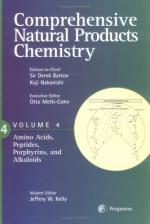|
This section contains 1,501 words (approx. 6 pages at 300 words per page) |

|
Amino acids are the building blocks of proteins and serve many other functions in living organisms. The prime function of DNA is to carry the information needed to direct the proper sequential insertion of amino acids into protein chain during protein synthesis (translation).
An amino acid is a molecule that contains a terminal acidic carboxyl group (COOH) and a terminal basic amino group (NH2). The approximately 20 amino acids (plus a few derivatives) that have been identified as protein constituents are alpha-amino acids in which the -NH2 group is attached to the alpha-carbon next to the -COOH group. Thus, their basic structure is NH2CHRCOOH, where R is a side chain. This side chain, which uniquely characterizes each alpha-amino acid, determines the molecules overall size, shape, chemical reactivity, and charge. There are hundreds of alpha-amino acids, both natural and synthetic.
The amino acids that receive...
|
This section contains 1,501 words (approx. 6 pages at 300 words per page) |

|


